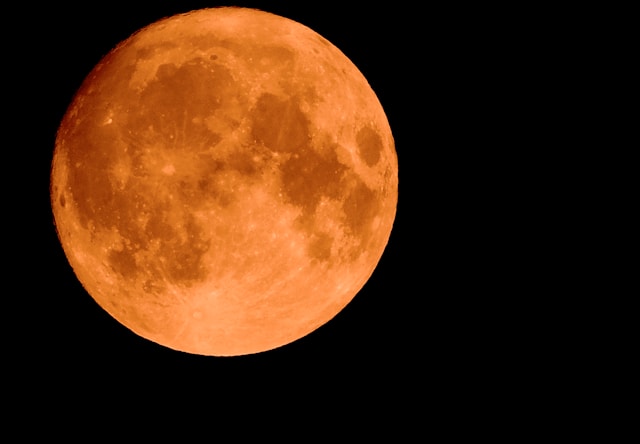
Introduction to the Phenomenon of the Orange Moon Tonight
Step outside tonight and look up at the sky. What do you see? A mesmerizing sight awaits as a spectacular orange moon graces the darkness, casting a warm glow over the world below. Tonight, nature is putting on a show that you won’t want to miss – an extraordinary display of color and beauty that is sure to leave you in awe. Join us as we delve into the science behind this enchanting phenomenon and uncover the mysteries of the captivating orange moon tonight.
What Causes an Orange Moon?
Have you ever gazed up at the night sky and been captivated by the sight of a glowing orange moon? The phenomenon of an orange moon is truly a mesmerizing sight that often leaves us in awe. But what exactly causes the moon to take on this striking hue?
The science behind an orange moon can be attributed to several factors working together in perfect harmony. One key factor is the Earth’s atmosphere, which plays a crucial role in altering the color of the moon as it rises above the horizon. When the moon is low in the sky, its light has to pass through a greater thickness of Earth’s atmosphere, causing shorter-wavelength colors like blue and green to scatter while longer-wavelength colors like red and orange prevail.
Additionally, during certain times of year, such as during fall when harvest moons are common, atmospheric conditions can further enhance this color transformation. The combination of these elements coming together creates the magical spectacle we know as an orange moon – a celestial event that never fails to leave us enchanted with wonder and curiosity.
The Role of Atmosphere and Sunlight in Creating Color Changes in the Moon
Have you ever looked up at the sky and noticed the mesmerizing hue of an orange moon? The science behind this captivating phenomenon lies in the intricate dance between Earth’s atmosphere and sunlight. As sunlight travels through our atmosphere, it undergoes a process known as Rayleigh scattering. This scattering effect causes shorter blue wavelengths to disperse while longer red wavelengths remain prominent.
When the moon is low on the horizon, its light has to pass through more of Earth’s atmosphere. This extended path scatters more blue and green light, leaving behind those warm tones of orange and red that we see from below. It’s like nature painting a masterpiece in the night sky for us to admire.
So next time you catch a glimpse of an orange moon tonight, take a moment to appreciate how nature’s elements come together to create such a stunning display above us.
The Connection Between Seasons and the Appearance of an Orange Moon
As we gaze up at the night sky, the color of the moon can sometimes surprise us. Have you ever noticed how during certain seasons, the moon appears more orange than usual? This phenomenon is not just a random occurrence but is actually connected to the time of year.
During autumn months, as the Earth’s tilt shifts and our days become shorter, it affects how sunlight interacts with our atmosphere. The lower angle of light causes particles in the air to scatter shorter wavelengths like blue and green, leaving longer red and orange hues to paint the sky – including on our lunar companion.
So next time you step outside on a crisp fall evening and catch sight of an orange moon glowing above, remember that it’s not just chance. It’s nature’s way of showing off its seasonal palette in celestial form.
Historical and Cultural Significance of Orange Moons
Throughout history, orange moons have captivated cultures around the world with their mystical allure. In ancient times, people believed that an orange moon was a sign of impending change or spiritual significance. Civilizations like the Egyptians and Mayans associated the orange moon with harvests, fertility, and powerful deities.
In folklore and mythology, stories were woven around the appearance of an orange moon, linking it to love, transformation, or even warnings of impending danger. From werewolf tales to celestial prophecies, the cultural interpretations of the orange moon vary greatly across different societies.
Artists throughout time have been inspired by the beauty of an orange moon hanging low in the night sky. Paintings, poems, and music often reflect this enchanting phenomenon as a symbol of mystery and wonderment.
Today’s modern society still holds onto some of these historical beliefs and customs surrounding the significance of experiencing an orange moon overhead. Whether viewed through a telescope or simply gazed upon from your backyard – witnessing this celestial event continues to evoke awe and fascination among people worldwide.
Tips for Observing the Orange Moon Tonight
Excited to witness the breathtaking sight of the orange moon tonight? Here are some tips to make your viewing experience even more memorable.
Find a location with minimal light pollution for optimal visibility. Whether it’s a rooftop, a park, or your backyard, choose a spot where you can see the moon clearly without interference from artificial lights.
Consider using binoculars or a telescope to get a closer look at the details on the lunar surface. This will enhance your viewing experience and allow you to appreciate the moon’s beauty in greater detail.
Don’t forget to check the weather forecast beforehand and dress accordingly. It’s essential to stay comfortable and warm while gazing at the mesmerizing orange glow of the moon.
Bring along some snacks and beverages to enjoy during your lunar observation session. A cozy blanket and some hot cocoa can add an extra touch of magic to your evening under the orange moonlit sky.
Frequently Asked Questions
Curious about the stunning orange moon lighting up the night sky tonight? Here are some answers to common questions you might have:
What time will the orange moon be visible tonight? The timing of the moonrise can vary depending on your location, so it’s best to check a local stargazing app for accurate information.
Why does the moon appear orange sometimes? This phenomenon occurs when the moon is low on the horizon, causing its light to pass through more of Earth’s atmosphere. The air particles scatter shorter wavelengths of light, leaving longer red and orange hues behind.
Can I capture a photo of the orange moon with my smartphone? While professional cameras may offer better quality images, smartphones with advanced camera features can still capture decent shots. Remember to use a tripod for stability and adjust your exposure settings accordingly.
Is there any significance or folklore associated with an orange moon? Various cultures around the world have myths and stories related to celestial events like this. From harvest moons marking agricultural seasons to lunar eclipses symbolizing change and renewal, interpretations abound.
Keep these FAQs in mind as you gaze at nature’s mesmerizing display in tonight’s sky!
Conclusion: Appreciating the Beauty and Science of the Orange Moon
As we gaze up at the sky tonight and witness the spectacular orange moon, let’s take a moment to appreciate the beauty and science behind this natural phenomenon. The combination of atmospheric conditions, sunlight angles, and seasonal changes all come together to create this mesmerizing sight.
Whether you’re a stargazing enthusiast or simply someone who enjoys marveling at nature’s wonders, the orange moon offers a unique opportunity to connect with the universe above us. So grab your binoculars or just step outside for a few moments tonight to witness this awe-inspiring spectacle.
Let’s continue to be curious about the world around us and embrace these rare occurrences that remind us of the magic and mystery of our universe. The next time you see an orange moon lighting up the night sky, remember to pause, reflect, and appreciate the beauty and science that brings such wonder into our lives.


